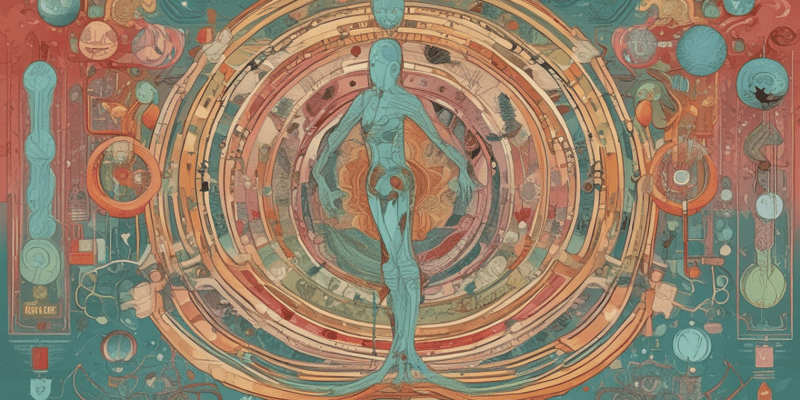Podcast Beta
Questions and Answers
What is the difference between a discipline, subdiscipline, multidiscipline, and interdisciplinary?
A discipline is a specific field of study, a subdiscipline is a branch within that field, multidiscipline involves multiple disciplines, and interdisciplinary combines concepts from multiple fields to address complex issues.
Which of these options describe the key themes in Biology? (Select all that apply)
The three elements that are the most important for life are ______.
carbon, hydrogen, oxygen
How do atoms bond to create molecules?
Signup and view all the answers
Living organisms maintain homeostasis.
Signup and view all the answers
What is Darwin's theory of natural selection?
Signup and view all the answers
What is the scientific classification system based on?
Signup and view all the answers
What are the four features that distinguish living from non-living things?
Signup and view all the answers
What is the relationship between DNA, genes, and alleles?
Signup and view all the answers
What are the three most important elements for life?
Signup and view all the answers
Biology does not affect personal health.
Signup and view all the answers
What allows living organisms to maintain homeostasis?
Signup and view all the answers
Which of the following are characteristics of life? (Select all that apply)
Signup and view all the answers
What is Darwin's theory of Natural Selection?
Signup and view all the answers
Atoms are composed of protons, electrons, and ______.
Signup and view all the answers
What is a macromolecule?
Signup and view all the answers
Study Notes
Intended Learning Outcomes
- Understand how science and biology support informed decision-making.
- Identify four key features that distinguish living organisms from non-living items.
- Learn the hierarchy of biological organization: atoms → molecules → macromolecules → cells.
- Recognize the relationship between DNA, genes, and alleles, and the differences in inheritance between sexual and asexual reproduction.
- Comprehend Darwin’s theory of Natural Selection.
- Classify living organisms using Linnaeus taxonomy.
- Connect common ancestors to the diversity of ecosystems and the scientific classification framework.
Science, Biology & Society
- Biology is the organized study of the natural world encompassing all matter and energy.
- The discipline arises from Greek origins: "bios" (life) and "logos" (thought).
- Personal health is influenced by biological understanding, including diet, exercise, injury, and disease.
- Knowledge of biology empowers informed personal and civic decisions.
Key Themes in Biology
- Cells are the fundamental units of life.
- Living organisms require and utilize energy.
- Interaction with the environment is essential for life.
- Homeostasis is vital for maintaining stable internal conditions.
- Growth and development are essential processes in living organisms.
- Genetic material acts as a blueprint for reproduction.
- Evolution occurs through changes in populations over generations.
- All species share a common evolutionary history.
- The relationship between structure and function is critical in biology.
- New properties of life emerge from interactions within biological systems.
- Biology is characterized as an experimental science with significant societal impact.
Characteristics of Life
- Metabolism/Energy: Involves chemical reactions that sustain living organisms.
-
Atoms, Elements & Molecules:
- All materials are made up of elements, which are pure substances composed of atoms.
- Atoms contain protons (positive), electrons (negative), and neutrons (neutral).
-
Chemical Bonding:
- Stability of atoms is achieved when the outer orbital is full; vacancies make atoms reactive.
- Atoms can bond chemically by sharing electrons to form stable molecules.
Molecules, Macromolecules & Cells
- Macromolecules are formed through the combination of multiple molecules.
- Main types of macromolecules include:
- Lipids: fats and oils important for energy storage and cellular structure.
- Proteins: essential for structure, function, and regulation of the body's tissues and organs.
- Carbohydrates: primary energy source and structural components in cells.
Distinction of Humans from Other Life Forms
- Understanding biological features helps to classify humans within the broader spectrum of life.
- Establishes the uniqueness of human functions, capabilities, and evolutionary background.
Intended Learning Outcomes
- Understand how science and biology support informed decision-making.
- Identify four key features that distinguish living organisms from non-living items.
- Learn the hierarchy of biological organization: atoms → molecules → macromolecules → cells.
- Recognize the relationship between DNA, genes, and alleles, and the differences in inheritance between sexual and asexual reproduction.
- Comprehend Darwin’s theory of Natural Selection.
- Classify living organisms using Linnaeus taxonomy.
- Connect common ancestors to the diversity of ecosystems and the scientific classification framework.
Science, Biology & Society
- Biology is the organized study of the natural world encompassing all matter and energy.
- The discipline arises from Greek origins: "bios" (life) and "logos" (thought).
- Personal health is influenced by biological understanding, including diet, exercise, injury, and disease.
- Knowledge of biology empowers informed personal and civic decisions.
Key Themes in Biology
- Cells are the fundamental units of life.
- Living organisms require and utilize energy.
- Interaction with the environment is essential for life.
- Homeostasis is vital for maintaining stable internal conditions.
- Growth and development are essential processes in living organisms.
- Genetic material acts as a blueprint for reproduction.
- Evolution occurs through changes in populations over generations.
- All species share a common evolutionary history.
- The relationship between structure and function is critical in biology.
- New properties of life emerge from interactions within biological systems.
- Biology is characterized as an experimental science with significant societal impact.
Characteristics of Life
- Metabolism/Energy: Involves chemical reactions that sustain living organisms.
-
Atoms, Elements & Molecules:
- All materials are made up of elements, which are pure substances composed of atoms.
- Atoms contain protons (positive), electrons (negative), and neutrons (neutral).
-
Chemical Bonding:
- Stability of atoms is achieved when the outer orbital is full; vacancies make atoms reactive.
- Atoms can bond chemically by sharing electrons to form stable molecules.
Molecules, Macromolecules & Cells
- Macromolecules are formed through the combination of multiple molecules.
- Main types of macromolecules include:
- Lipids: fats and oils important for energy storage and cellular structure.
- Proteins: essential for structure, function, and regulation of the body's tissues and organs.
- Carbohydrates: primary energy source and structural components in cells.
Distinction of Humans from Other Life Forms
- Understanding biological features helps to classify humans within the broader spectrum of life.
- Establishes the uniqueness of human functions, capabilities, and evolutionary background.
Studying That Suits You
Use AI to generate personalized quizzes and flashcards to suit your learning preferences.
Related Documents
Description
This quiz focuses on the major themes in biology as they relate to health science. Students will explore the fundamentals of biology, including the characteristics of life, the relationship between biological structures, and the role of DNA in inheritance. Prepare to demonstrate your understanding of these essential concepts.




